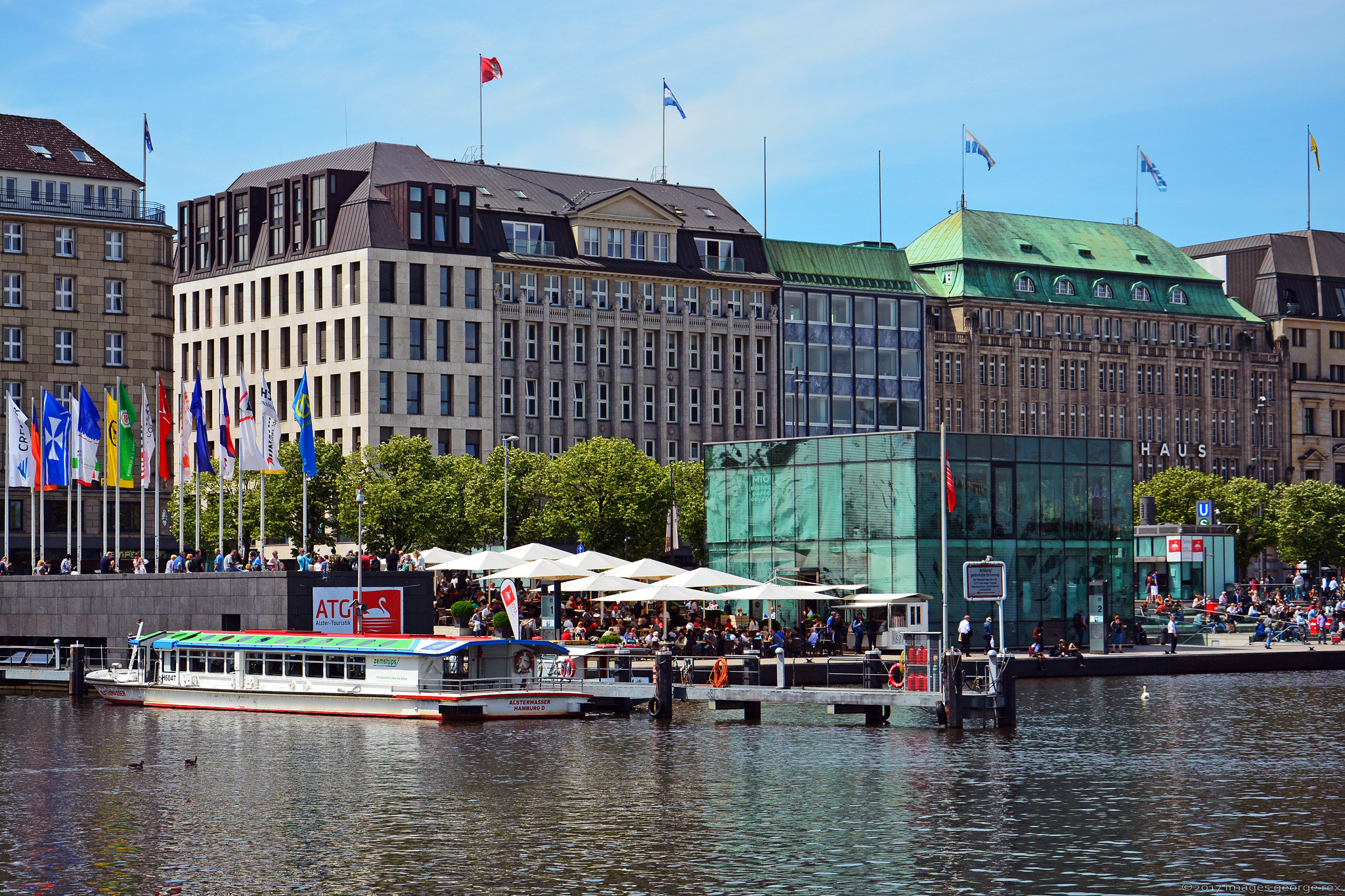Jungfernstieg is a prominent promenade and shopping street located in the heart of Hamburg, Germany. Situated along the southwestern shore of the Binnenalster lake, it is one of the city’s most popular and historic areas. Established in 1235, Jungfernstieg was originally a path used by the daughters of wealthy Hamburg families for their daily walks, hence its name, which translates to “Maiden’s Walk.” Today, it is a bustling urban center known for its high-end shops, cafes, and cultural attractions. The street features a mix of historic and modern architecture, including the iconic Alsterhaus department store. Jungfernstieg also serves as a transportation hub, with boat landings, bus stops, and a major subway station, making it a central point for both locals and tourists exploring Hamburg.
Nestled along the picturesque Binnenalster lake in the heart of Hamburg, Germany, lies the iconic Jungfernstieg promenade. This bustling thoroughfare has been a focal point of the city’s social and commercial life for centuries, drawing locals and tourists alike with its charm and rich history.
The story of Jungfernstieg dates back to the early 17th century when it was nothing more than a simple footpath along the Alster riverbank. Its name, which translates to “Maiden’s Walk,” is said to have originated from a charming local tradition. Wealthy families would stroll along the path on Sundays, showcasing their unmarried daughters in hopes of attracting suitable suitors. This practice gave the promenade its unique moniker and set the stage for its future as a hub of social activity.
As Hamburg grew and prospered, so did Jungfernstieg. The 19th century saw significant developments that transformed the once-humble footpath into a grand boulevard. In 1838, the promenade was widened and paved, making it more accessible and appealing to the city’s growing population. This renovation marked the beginning of Jungfernstieg’s evolution into a fashionable destination for Hamburg’s elite.
The promenade’s popularity continued to soar, and by the late 19th century, it had become a hotspot for luxury hotels, high-end shops, and elegant cafes. The famous Alsterhaus department store, which still stands today, opened its doors in 1912, further cementing Jungfernstieg’s reputation as a premier shopping destination. These establishments attracted visitors from all over Europe, turning the area into a symbol of Hamburg’s prosperity and cosmopolitan flair.
However, Jungfernstieg’s journey hasn’t always been smooth sailing. The promenade suffered significant damage during World War II, with many of its historic buildings reduced to rubble. In the post-war years, Hamburg’s residents rallied together to rebuild and restore their beloved landmark. This resilience in the face of adversity is a testament to the deep connection between Jungfernstieg and the people of Hamburg.
Today, Jungfernstieg continues to be a vibrant and essential part of Hamburg’s urban landscape. The promenade has undergone several renovations in recent decades to accommodate modern needs while preserving its historic charm. In 2006, a major redevelopment project saw the introduction of new pedestrian areas, improved lighting, and enhanced accessibility features, making the space more inviting than ever.
Visitors to Jungfernstieg can now enjoy a perfect blend of old-world elegance and contemporary amenities. The promenade is lined with a diverse array of shops, from international luxury brands to local boutiques, catering to all tastes and budgets. Food lovers can indulge in everything from traditional German cuisine to international delicacies at the numerous restaurants and cafes that dot the area.
One of the most enchanting aspects of Jungfernstieg is its ever-changing atmosphere throughout the year. In summer, the promenade comes alive with outdoor seating areas, street performers, and boat tours on the Alster. Winter brings a magical transformation as the annual Christmas market takes over, filling the air with the scent of mulled wine and the sound of carols.
As Hamburg continues to evolve, Jungfernstieg remains a constant reminder of the city’s rich heritage and enduring spirit. It serves not only as a popular tourist destination but also as a beloved gathering place for locals, who come to shop, dine, or simply enjoy a leisurely stroll along the waterfront. The promenade’s ability to adapt and thrive through centuries of change is a testament to its enduring appeal and significance in Hamburg’s cultural landscape.
Jungfernstieg, located in Hamburg, Germany, is a prominent waterfront promenade and major shopping destination. As one of the city’s oldest and most iconic streets, it offers a blend of historical significance and modern urban life. The area features high-end retail stores, cafes, and cultural attractions, making it a popular spot for both locals and tourists. Its picturesque setting along the Alster Lake, combined with its vibrant atmosphere and architectural beauty, solidifies Jungfernstieg’s status as a key landmark in Hamburg’s cityscape and a symbol of the city’s prosperity and charm.

